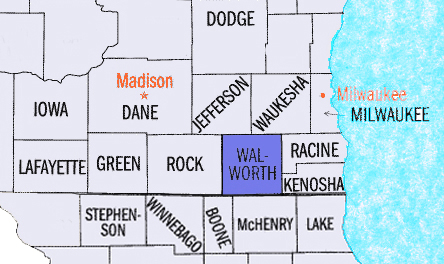Walworth County HistoryWalworth County is one of the southern tier counties in Wisconsin. It is bounded on the north by the counties of Jefferson and Waukesha; east, by Racine and Kenosha Counties; south, by the State line; and west by Rock county. Its eastern line is twenty-four miles west of the shore of Lake Michigan. Elkhorn, the county seat and geographical center of the county, is in latitude 42 ° 48' north, and longitude 88° 26' west. The county embraces sixteen congressional townships of six miles square, and constitutes a square of four towns on each side. It is not recorded that any white man ever visited the region prior to 1830. As far back as 1663, Joliet coasted up the western shore of Lake Michigan, and touched at points along the coast, and Allouez, as early as 1665, was at Green Bay. In 1671, the Jesuits had established a mission at what is now De Pere, Brown County, and from that point ministered to the benighted Indian tribes of Wisconsin. In none of the records of these early explorers is any mention made of the region lying inland between the foot of the lake and the mouth of the Milwaukee River. It is therefore almost certain that the land was unknown to the explorers of the seventeenth and eighteenth centuries. And that, up to the time of general Western immigration, which commenced after the close of the Black Hawk war, in the summer of 1832, no white man had lived within the boundaries of the present county, and none had visited the region, except, perchance, some fur-trader. The history of Walworth County began with the history of the Territory of Wisconsin. One of the earliest acts of the first Territorial Legislature was to divide, geographically, the domain into counties sufficiently small to enable the citizens of the new country to begin under the forms of law. At that time, Milwaukee and Brown Counties, under the old laws of Michigan Territory, embraced all of what is now Wisconsin east of a meridian running north and south through the boundaries of Walworth County were defined. It was one of the original counties of Wisconsin, and was named "Walworth: in honor of Chancellor Walworth, of New York, at the suggestion of Col. Samuel F. Phoenix, then a pioneer settler of Delavan, who attended the session as a lobby member. The county, by the organic act, which defined its geographical boundaries, had none of the functions of self-government conferred upon it. It was attached to Racine County for judicial purposes, and, except in the election of Commissioners, who had the power to lay out roads and levy school taxes, was essentially a part of that county till 1838, at which time the first town organizations were made, and provisions made whereby it took upon itself the functions of an independent government. During the time intervening between the erection of the county, in 1836, and its organization, in 1838 and 1839, the county was settled, and experienced all the throes incident to the birth and establishment of a new life in a new country. Prior to January, 1836, it is believed that no efforts had been made to secure any permanent land title, except those of Hodgson-Brink party. John Brink and John Hodgson were the original surveyors, having taken a contract to run the town lines of what are now Rock and Walworth Counties. Reuben T. Ostrander and William Ostrander were also in the party and made claims. Early in 1836, the prospectors began to appear, and, by the opening of the winter of 1836-37, considerable settlements had been made at several points in the county, where the most important villages now are. The actual residents, who had erected cabins and determined to remain, numbered not far from two hundred, including men, women and children. A peculiar interest attaches to these early settlers of 1836. They were Pilgrim Fathers of Walworth County. They comprised thirty-one families, and some thirty men without families. The names of such as are known, with the first place of settlement, are given below:
In addition, several men without families had taken up claims. Palmer Gardner, I. T. Hunt, Horace Coleman, A. L. Merrick, Samuel Britton, David Patten, Perrin Smith, Joel Smith, William J. Bentley, Daniel Salisbury and Benjamin C. Perce were located in the vacinity of the Spring Prairie settlements; Alpheus Johnson, Henry Johnson and S. A. Dwinnell were in La Fayette; John Davis was at Sugar Creek; Col. Samuel F. Phoenix and several hired men were at Delavan; and Charles A. Noyes, William Ostrander, Samuel Ross, Jonathan Ward, George W. Trimble and two or three others, whose names are not remembered, wintered at Geneva. There were also several men without families at the Troy settlements. At East Troy were Gorham Bunker and Elias Jennings, both married men, who made their claims, but did not bring in their families till 1837. Also, Delanson and Reuben Griffin, and possibly Allen Harrington and Gaylord Graves. In Troy were the three grown sons of Jesse Meacham, Edwin and Edgar, and Urban D. Also Sylvanus Spoor, a cousin to Adolphus; Alex Beardsley, a young man named Roberts, and one or two other unmarried men, who came in from Indiana with Othni Beardsley and family. The Robinsonn brothers, John and Simeon, made claims and stayed during the summer, but did not winter there. A young man named Ruggles also came in with Spoor. Excerpted from "History of Walworth County 1882" Copyright 2013 Walworth County Genealogical Society
| |||||||


